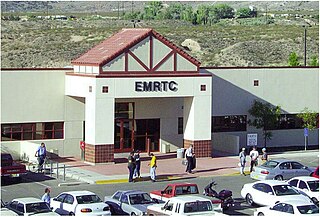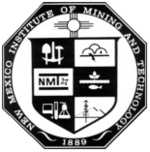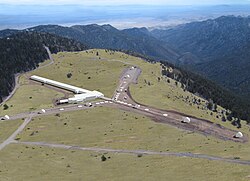
Socorro is a city in Socorro County in the U.S. state of New Mexico. It is in the Rio Grande Valley at an elevation of 4,579 feet (1,396 m). In 2010 the population was 9,051. It is the county seat of Socorro County. Socorro is located 74 miles (119 km) south of Albuquerque and 146 miles (235 km) north of Las Cruces.

The Florida Institute of Technology is a private research university in Melbourne, Florida. The university comprises four academic colleges: Engineering & Science, Aeronautics, Psychology & Liberal Arts, and Business.Approximately half of FIT's students are enrolled in the College of Engineering & Science. The university's 130-acre primary residential campus is near the Melbourne Orlando International Airport and the Florida Tech Research Park. The campus is located 16 miles from Patrick Space Force Base. The university was founded in 1958 as Brevard Engineering College to provide advanced education for professionals working in the U.S. space program at the Kennedy Space Center and Space Launch Delta 45 at Cape Canaveral Space Force Station. Since 1966, when it combined the Institute of Technology (FIT) following University of Central Florida's name change, FIT has gone by its current name Florida Tech. In 2021, Florida Tech had an on-campus student body of 5,693 between its Melbourne Campus, Melbourne Sites, and Education Centers, as well as 3,623 students enrolled in their online programs, almost equally divided between graduate and undergraduate students with the majority focusing their studies on engineering and the sciences. Florida Tech is classified among "R2: Doctoral Universities – High research activity".

Established in 1918, Tallinn University of Technology is the only technical university in Estonia. TalTech, in the capital city of Tallinn, is a university for engineering, business, public administration and maritime affairs. TalTech has colleges in Tartu and Kohtla-Järve. Despite the similar names, Tallinn University and Tallinn University of Technology are separate institutions.

David E. Thomas is a scientist and software engineer best known for his scientific skepticism research and writings. He is a graduate of the New Mexico Institute of Mining and Technology, and his skeptic work covers the Roswell and Aztec UFO sightings, the Bible code, global warming, the 9/11 Truth movement and chemtrails. Thomas is frequently published in Skeptical Inquirer magazine.

Mehran University of Engineering & Technology is a public research university located in Jamshoro, Sindh, Pakistan focused on STEM education.
The Cockrell School of Engineering is one of the eighteen colleges within the University of Texas at Austin. It has more than 8,000 students enrolled in eleven undergraduate and thirteen graduate programs. Annual research expenditures are over $267 million and the school has the fourth-largest number of faculty in the National Academy of Engineering.

The National Wind Institute (NWI) at Texas Tech University (TTU) was established in December 2012, and is intended to serve as Texas Tech University's intellectual hub for interdisciplinary and transdisciplinary research, commercialization and education related to wind science, wind energy, wind engineering and wind hazard mitigation and serves faculty affiliates, students, and external partners.
Charles Bachman Moore Jr. was an American physicist, engineer and meteorologist, known for his research on atmospheric physics and his work with gas balloons. He was born in Maryville, Tennessee.

The Magdalena Ridge Observatory (MRO) is an astronomical observatory in Socorro County, New Mexico, about 32 kilometers (20 mi) west of the town of Socorro. The observatory is located in the Magdalena Mountains near the summit of South Baldy Mountain, adjacent to the Langmuir Laboratory for Atmospheric Research. Currently operational at the site is a 2.4-meter fast-tracking optical telescope, and under construction is a ten-element optical interferometer.
The National Taiwan University of Science and Technology, abbreviated as NTUST or TaiwanTech, is a public vocational university located in Taipei, Taiwan. TaiwanTech was established in 1974 as the National Taiwan Institute of Technology, as the first and the leading higher education institution of its kind within Taiwan's technical and vocational education system. NTUST is affiliated with National Taiwan Normal University and National Taiwan University as part of the National Taiwan University System.

The Lower Erebus Hut (LEH) is a permanent field facility located on Mount Erebus on Ross Island, Antarctica. The hut served as the seasonal base of the Mount Erebus Volcano Observatory (MEVO), run by New Mexico Institute of Mining and Technology (NMT). The installation comprises two huts, one kitchen and recreation building and one working and storage building.

The Edward E. Whitacre Jr. College of Engineering is the college of engineering at Texas Tech University in Lubbock, Texas. The engineering program has existed at Texas Tech University since 1925. Additionally, the Whitacre College of Engineering administers graduate engineering degree programs at the university's campus in Amarillo, Texas. Many of the college's degree programs are accredited by ABET. The Whitacre College of Engineering is the first and, presently, only school in the world to offer a doctor of philosophy degree in wind science and engineering.

The Gubkin Russian State University of Oil and Gas is a public university in Moscow, Russia. The university was founded in 1930 and is named after the geologist Ivan Gubkin. The university is colloquially known as Kerosinka, meaning 'kerosene stove'.

Rajiv Gandhi Institute of Petroleum Technology (RGIPT), in Jais, Amethi, Uttar Pradesh, India, is a training and education institute focusing on STEM and petroleum industry under IIT Kanpur. It was formally opened in July 2008.

The Energetic Materials Research and Testing Center (EMRTC) is a research division of New Mexico Tech, which performs testing of high explosives, bombs, and other munitions, as well as the means to deliver such munitions. It also offers courses for emergency responders in bomb response. EMRTC's offices are in Socorro, New Mexico. The 40-square-mile (100 km2) field testing and training areas are located west of town in Socorro County and they have an anti-terrorist training site in Playas, New Mexico, in Hidalgo County.
Explosives engineering is the field of science and engineering which is related to examining the behavior and usage of explosive materials.
DR. Mahdi S. Hantush (1921–1984) was a prominent Iraqi-born American hydrologist known for his analytical work on leaky aquifers and well hydraulics. He was the founder of the New Mexico Tech Hydrology Program. His granddaughter is Yasmin Younis, the 2018 Student Commencement Speaker at Boston University’s 185th Commencement, which went viral all over the Middle East. His Son, Mohamed Hantush, is a Civil Engineer for the Environmental Protection Agency and resides in Cincinnati Ohio

The Virginia Tech College of Engineering is the academic unit that manages engineering research and education at Virginia Tech. The College can trace its origins to 1872, and was formally established in 1903. Today, The College of Engineering is the largest academic unit of Virginia Tech and has 14 departments of study. Its undergraduate program was ranked 4th and its graduate program was ranked 30th among doctoral-granting universities by U.S. News & World Report in 2018. In 2014–15, the College of Engineering consisted of 10,059 students. The current dean is Dr. Julia Ross.

The New Mexico Exoplanet Spectroscopic Survey Instrument (NESSI) is a ground-based near-infrared spectrographic system specifically designed to study the atmospheres of exoplanets. The NESSI instrument was mounted in 2014 on a 2.4 meter telescope at the Magdalena Ridge Observatory in Socorro County, New Mexico, USA, achieving first light on 7 April 2014.
Miguel A. Marino is an American engineer, currently the Distinguished Professor Emeritus of Hydrologic Sciences, Civil and Environmental Engineering and Biological & Agricultural Engineering at University of California, Davis, and also a published author. He was honored as a Distinguished Member of the American Society of Civil Engineers (ASCE) in 1999, and a Life Member in 2005, as well as being the ASCE's Editor of its journal Journal of Water Resources Planning and Management in 1984-88.

















